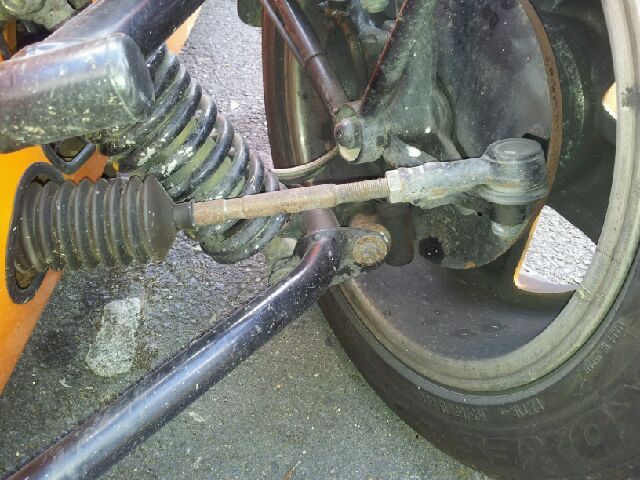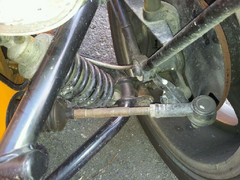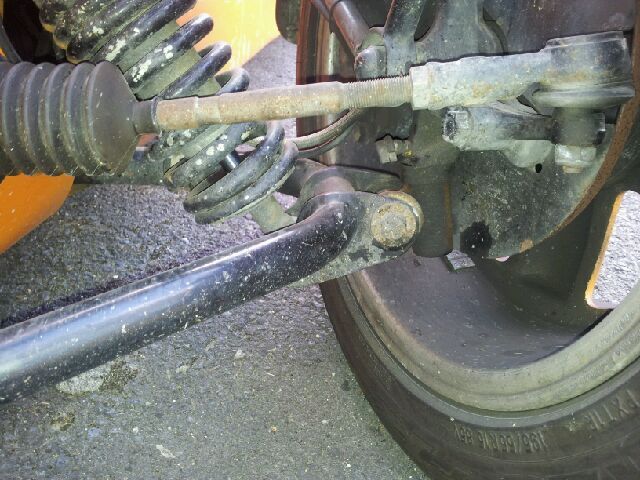
Martin1

Morning all,
Can anyone help me with a little info on the classic Triumph front upright please. What I need to find out:
1 The overall 'width' at the bottom fixing. By width I mean measured in the same direction as the fixing bolt, ie front/rear when fitted
to the car
2 As the angle of the lower fixing bolt effectively fixes the castor angle is this bolt at an angle in the wishbone or does the geometry of the
upright create the necessary castor with the fixing bolt horizontal?
Thanks in advance.
Mike
when you say width, I presume you mean the brass trunnion? with bushes? (can't see you can fit it without)
On spitfires et al the castor is set using shims on the lower wishbone, adding more to fron/rear as required.
Will sort measurements...
quote:
Originally posted by cliftyhanger
when you say width, I presume you mean the brass trunnion? with bushes? (can't see you can fit it without)
On spitfires et al the castor is set using shims on the lower wishbone, adding more to fron/rear as required.
Will sort measurements...
Shimming the bottom wishbone mainly affects camber not castor. Its only about 1 to 1.5 degree of castor you can change with shimming the mounts. The
position of the chassis mountings therefore determines castor as there appears to be none built in to the upright itself. The bolt at the bottom
securing the trunnion to the wishbone appears to be 'square' to the wishbone and upright.
So in summing up you need to build in castor when you place your chassis mounts. Aprox 4-6 degrees.
quote:
Originally posted by chillis
Shimming the bottom wishbone mainly affects camber not castor. Its only about 1 to 1.5 degree of castor you can change with shimming the mounts. The position of the chassis mountings therefore determines castor as there appears to be none built in to the upright itself. The bolt at the bottom securing the trunnion to the wishbone appears to be 'square' to the wishbone and upright.
So in summing up you need to build in castor when you place your chassis mounts. Aprox 4-6 degrees.
Iv got spitfire/herald uprights on mine, tried dialling in more castor as its very twitchy at speed, can you upload picturesd of your set up?
quote:
Originally posted by maccmike
Iv got spitfire/herald uprights on mine, tried dialling in more castor as its very twitchy at speed, can you upload picturesd of your set up?






quote:
Originally posted by MikeCapon
quote:
Thanks for the info. Shimming the wishbone left/right (if indeed that is possible) will change just camber, whilst shimming front/rear will surely only affect the castor?
To a point, yes but as you take out 'front' shims to increase castor the total camber does reduce. The shims are for adjustment to account for production tolerances so you don't get much with the shims. either for castor or camber. Ok if you only need to make small adjustments but if there if a fundamental shortfall in castor then the only way to change that is by moving the chassis pick ups.
I had considered the original question as someone wanting to know if they needed to 'build' in castor or whether the suspension 'contained' the castor within the production parts.
[Edited on 29/9/12 by chillis]
cliftyhanger - 29/9/12 at 05:55 PM39.5mm is thegap between the wishbone for the trunnion (when fitted and bolted up)
Castor should be 4 degrees positive according to the WSM. Generally thought to be the best setting...and the wsm also explains castor is set by swapping shims. No change in pickup is available, but I guess you could use adjustable wishbones.
britishtrident - 29/9/12 at 06:26 PMquote:
Originally posted by chillis
Shimming the bottom wishbone mainly affects camber not castor. Its only about 1 to 1.5 degree of castor you can change with shimming the mounts. The position of the chassis mountings therefore determines castor as there appears to be none built in to the upright itself. The bolt at the bottom securing the trunnion to the wishbone appears to be 'square' to the wishbone and upright.
So in summing up you need to build in castor when you place your chassis mounts. Aprox 4-6 degrees.
ISTR Trunnion is not Square to the upight cl but the nominal caster angle is cast into to trunnion.
I would advise the op should buy a trunnion overhaul kit and work from that
Andy S - 29/9/12 at 06:51 PMTriumph suspension
The shims are for camber only.
Caster is set by the angle of the lower wishbone in relation to the chassis - For a light car such as the 7 5.5-7 degrees is around the optimum - On the Lotus this is taken care of by the chassis kicking up at the front.
With trunnions there is no possibility to alter caster by any other means than changing the chassis pick up location - Later Caterhams achieved Caster adjustment with a different upright that did not use the trunnion - The trunnion always moves at right angles to the wishbone and you cannot tilt it in the wishbone without damage.
Andrew
MikeCapon - 2/10/12 at 08:54 AMThank you all for your advice. Cliftyhanger, thanks for the measurement. The bent bones I have here were at just under 40mm so that's a goer.
Also looking at the bent bones the plates that hold the trunnion are set back by around 8° so to start with I'm going to build 5° into mine.
I'll post some pics later when there's abit more than a load of bent tube on my bench.
Cheers,
Mike
cliftyhanger - 2/10/12 at 09:11 AMquote:
Originally posted by Andy S
Triumph suspension
The shims are for camber only.
Check the Triumph WSM. It states clearly how castor is adjusted, and that is by shims. It really is simple, add a shim at the front, take a rear one out. No change to camber but the trunnion is set further back. Not a lot, but that is how it was done on the cars originally (and still is).
I guess it would be possible to build a wishbone with a larger gap for the trunnion, and use shims either side to make the adjustment.
chillis - 2/10/12 at 09:44 AMAs stated prevoiusly it IS possible to adjust castor using the shims but you will decrease the negative camber when doing so, also the effect on castor is very small. Its not dissimilar to the way camber and caster are set on my MX5 only the 5 has proper eccentric adjuster bolts.
The trunnion is square to the upright/wishbone and running a straight edge over an upright at the weekend it doesnt appear to have an offset
If I could figure out loading up pictuires I could post a picture showing this.
I suspect the OP has a chassis that doesn't have enough caster built in and there won't be any way to overcome that without moving the chassis pickup points.
chillis - 2/10/12 at 09:46 AMquote:
Originally posted by MikeCapon
Thank you all for your advice. Cliftyhanger, thanks for the measurement. The bent bones I have here were at just under 40mm so that's a goer.
Also looking at the bent bones the plates that hold the trunnion are set back by around 8° so to start with I'm going to build 5° into mine.
I'll post some pics later when there's abit more than a load of bent tube on my bench.
Cheers,
Mike
I would check those 'bones' out the ones I have are straight.
Andy S - 2/10/12 at 04:59 PMThat's not adjusting Caster - that's adjustment for misalignment issues with the top wishbone
quote:
Originally posted by cliftyhanger
quote:
Originally posted by Andy S
Triumph suspension
The shims are for camber only.
Check the Triumph WSM. It states clearly how castor is adjusted, and that is by shims. It really is simple, add a shim at the front, take a rear one out. No change to camber but the trunnion is set further back. Not a lot, but that is how it was done on the cars originally (and still is).
I guess it would be possible to build a wishbone with a larger gap for the trunnion, and use shims either side to make the adjustment.
chillis - 2/10/12 at 08:12 PMHaving spent some of this evening looking at a friends spitfire, the lower wishbones where the trunnion bolts to is NOT angled but square to the wishbones. The wishbones themselves are angled relative to the horizontal plane. ie the wishbones are at an angle - raised at the front - and NOT parallel to the ground. The upper wishbones are parallel to the lower wishbones.
The trunnion is in line with the upright with its centreline running through the middle of the stub axle line and through the middle of the upper balljoint.
It also looks to me that if the shims were added to push the lower end of the upright forward increasing caster then some side loading would ocurr at the trunnion as it would be pulled out of line with the top. Remember the trunnion is NOT a ball joint and acts in only two planes.
To that end I have to agree with Andy S, caster cannot 'properly' be adjusted by using the shims, indeed it says as much in the workshop manual.
Caster is therefore built into the chassis and it must be concluded the caster is NOT part of the wishbones or uprights.
As for adjustment as said earlier the shims only provide a small amount of adjustment to allow for manufacturing tolerances and NO major changes to the caster or indeed camber can be made by the shims alone.
Hope this info gets to you before its too late